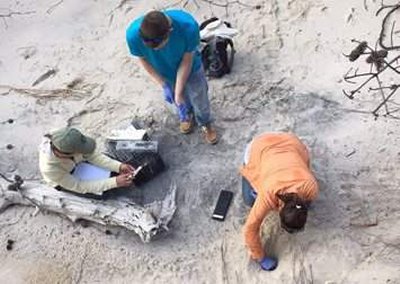
Diamondback Terrapin Study volunteers Lizzy Jenny, Atlantic Test Ranges Sustainability Office, prepares a scale for weighing eggs; Hospitalman Timothy Maxey dons gloves for safe egg handling; and biologist Sarah Funck, study coordinator, excavates the eggs from a turtle nest. Data collected from the ongoing study is reported to the U.S. Fish and Wildlife Service. This year, volunteers documented around 110 nests. (Courtesy photo by Capt. Ben Shevchuk, NAS Patuxent River)
PATUXENT RIVER, Md.—Neither sand, nor heat, nor biting insects can prevent a dedicated group of volunteers from the swift completion of their appointed rounds, surveying the nests of Diamondback Terrapins aboard NAS Patuxent River.
For more than two months, the group—comprised of Sailors, civilians, contractors and retirees—has scoured Pax River’s beaches looking to first locate terrapin nests, and now to follow them closely through hatching.
“During nesting season, which starts in mid-May, we’re out there once per day usually between 4 p.m. and 6 p.m. looking for as many nests as we can find,” explained biologist Sarah Funck, who first led the terrapin study as a student intern when it began three years ago. “The females seem to nest during the earlier part of the day, and if we give them that time undisturbed, we can go through later looking for nests and probably won’t miss much. During hatching season, now through early October, we’ll be out there twice per day.”
Funck, who went on to earn a master’s degree and land a full-time job, continues to coordinate the Pax study as a volunteer.
“I do it because I love it; it’s my passion,” she noted. “In my current job, I sit in front of a computer or am in the lab. This takes care of that side of me that needs to be out in the field, getting dirty and doing the work.”
A species of concern
The terrapin project is being conducted under the guidance of Pax River’s Natural Resources Department.
“Chesapeake Bay terrapin populations have been plummeting at an alarming rate for years, yet Pax River’s habitat seems to support one of the largest breeding populations in this part of the Chesapeake Bay,” explained Kyle Rambo, conservation director. “And since our population is one of the most intensely studied, it’s important for the Navy to contribute to the ongoing research of this species, which is an important resource, both ecologically and economically.”
Research goals include determining and documenting breeding success, local population demographics, hatchling and adult survival and mortality rates, and longevity—in addition to simply helping to sustain healthy populations of terrapins in this region, Rambo said.
When volunteers find a nest, they’ll cage it for protection from predators and to contain the eventual newborn turtles in order to obtain measurements and collect data. Afterward, they’ll remove the cage, releasing the hatchlings into the wild.
“We’ve learned that with our cages to protect the nest, we’re giving them a little boost at birth,” Funck noted. “But they’ll have many obstacles to overcome, such as invasive species, habitat destruction, coastal development, crab trap issues and predators. It’s a guesstimate that only one to 10 percent survive to maturity, which takes about eight years.”
Welcoming habitat
Pax’s open white sandy beaches, dunes and maritime forest provide the terrapins an ideal habitat, and one that is becoming sparser throughout the state.
“They’re about the size of a quarter when they emerge as hatchlings,” Funck said. “The beaches at Pax, especially near the Beach House, are surrounded by marsh habitat, which is their foraging area; they can hunker down in the marsh grasses or leaf litter; overwinter in the river; and even nest right here. They can stay in a localized area and get pretty much what they need to complete their lifecycle.”
Rambo said the study is expected to continue into the foreseeable future for as long as there is a dedicated champion like Funck and a small army of volunteers willing to perform the laborious work required.
“They log long hours and walk many miles,” he added. “All for the simple satisfaction of knowing they’re doing something meaningful and making a difference not only at Pax River, but within the larger Chesapeake Bay community.”


